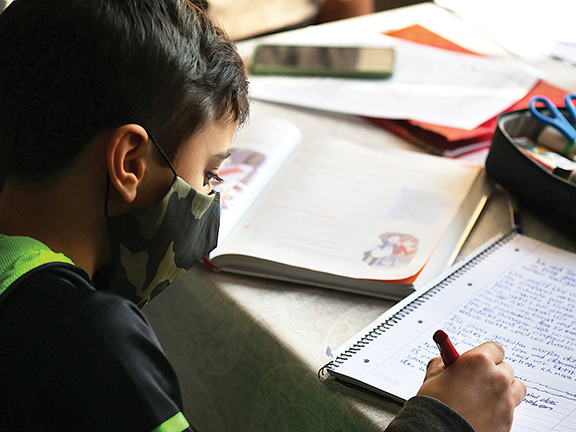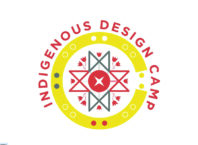By Lee Egerstrom
Urban area students in younger grades are finding their way back into school classrooms while educators keep their fingers crossed that another surge in COVID-19 infections won’t push all students back into distance learning regimes.
This is especially so for teachers and school administrators who have Native American students in their classes, said Joe Rice, executive director of the Nawayee Center School in Minneapolis and the facilitator of the Phillips Indian Educators (PIE) professional education group.
“Distance learning is the opposite of what really works for a lot of our students,” Rice said. Culturally geared education requires in-person relationships, active participation with others and faculty, and with Indigenous cultures; and interdisciplinary work with curricula, he said.
“Our students’ health – mental, physical, spiritual and emotional – is our biggest concern and the area of our greatest need,” he said. “This is largely because our culture is centered on relationships and the science of relationships.”
The COVID-19 pandemic brought what had been working for large numbers of Native schools and others from various cultures to a screeching halt last spring. Schools were closed and education shifted to distance learning and various “hybrid” models of some in-person and out of classroom, or distance learning, classes throughout Minnesota.
State guidelines based on county infection rates, hospitalizations and death data steered state officials and local school administrators on how to proceed with education models. Until recently, that meant most urban schools were closed to in-person classes.
The Anoka-Hennepin Schools District, the largest in the state covering suburban communities in Hennepin and Anoka counties, had kindergarten through second graders return to schools in mid-January. Grades three through five were to resume in school on Feb. 1.
St. Paul Public Schools also chose to return kindergarten through grade two classrooms on Feb. 1, with grades three through five set to return to schools on Feb. 16.
Minneapolis schools used fresh COVID data from the Minnesota Department of Health with Governor Walz’s “Safe Learning” guidelines to set reopening plans. Pre-kindergarten and kindergarten classes are to resume on Feb. 8. Grades one and two return on Feb. 10, and Feb. 22 was set for the return of grades three through five. Middle school and high school classes will remain with distance learning for the foreseeable future.
This won’t alter how Rice and his faculty of 13 teachers reach students at Nawayee Center School, 2421 Bloomington Ave. S. in Minneapolis. The Center School (Nawayee is an Ojibwe word for “the center”) has 55 students in grades six through 12. Most are of Dakota or Ojibwe origin.
This still leaves older students distant from their teachers and from one another, a problem for many Native students who learn, grow and gain strength from cultural relationships, said Rice and Braden Canfield, a social worker with the Indian Education Department for Minneapolis Public Schools.
A subgroup of the Phillips Indian Educators, Attendance Workgroup, coordinate on ways to connect Native students and keep them engaged with their classes. It especially stresses the importance of attendance that can become a problem when students are taking classes on line or using electronic devices and not in classrooms.
Partners in this effort include Division of Indian Work, Migizi Communications, Little Earth, the MPS Indian Education Department, Hennepin County Library and the Hennepin County “Be At School” program.
A big help is coming from a grant and program at EdVisions Inc., a Bloomington-based education nonprofit group. With it, Center School is developing a technology lab that is essentially a broadcast studio in the school. It will be used to make teaching and family contact easier for students and educators, and become a technology training program for students as well.
This could be a technological development that will engage artistic students long after the pandemic and distance learning have passed, Rice said.
EdVisions is currently working on innovative projects with 11 schools in Minnesota, North Dakota and South Dakota as part of a Midwest School Transformation Project.
Participating schools with significant Native students include the Wichakini Owayawa – Lakota Language Immersion Next at Fort Yates, in North Dakota; the Porcpine School in Porcupine, S.D.; and in Minnesota, the Prior Lake-Savage schools and Nawayee Center School.
Julene Oxton, the project’s transformation and development director, said the pandemic hit about midway through the three-year program that is supported by the Bush Foundation. COVID restricted travel and caused other interruptions. EdVisions then turned to the schools for guidance on creative ways to circumvent problems surrounding distance learning and lack of contact between teachers and students.
“Educational disparities among communities and families were obvious,” she said. EdVisions helped Center School get electronic devices to students who needed them to take classes via cyberspace.
And this year, Oxton said, the program provided an $18,000 grant to Center School to equip the technology lab.
This is consistent with EdVisions’ mission in supporting schools to transform from an institutional, or industrial model of operations to a student centered, or student-driven learning environment, she said.
It will also help teachers design and engage in transformative education models such as better use of space, time, personnel, technology and standards to meet the needs of students.
Professional coaches from the education group also work with the participating schools’ faculty and administrators in designing and carrying out new approaches.
The EdVisions website shows how the Center School could use the studio linkage with its student-centered and project-oriented academic approach.
The importance for this school year is great. There are no current plans for Minneapolis high school students to return to classes in the current school year, Rice said. And getting proper technology into the homes and into the students’ hands is still a problem with many Native students.
Education leaders from the state level on down to the schools all warn the end of the COVID pandemic and restrictions on in-person classes may not be coming to an end in the current school year. While infection rates have been falling after the holiday season surges, new variants of the coronavirus from the UK and Brazil have reached Minnesota and may be more contagious that the original variety.
What’s more, the return to classrooms in the younger years isn’t mandatory for students and families.
“Going back to school is an option. All families have the choice to go back or stay with distance learning,” said Minneapolis Public Schools’ Canfield.
Parents and students should continue to monitor breaking COVID and school news offered online by local school districts. State information from the Minnesota Department of Health that will shape school decisions can be found at
https://www.health.state.mn.us/diseases/coronavirus/situation.html;
and Minnesota Department of Education, https://education.mn.gov/MDE/about/plan.
Information about the Phillips Indian Educators can be found at http://pieducators.com
and EdVisions Inc.’s work with Nawayee Center School is at
https://edvisions.org/what-makes-learning-relevant.







